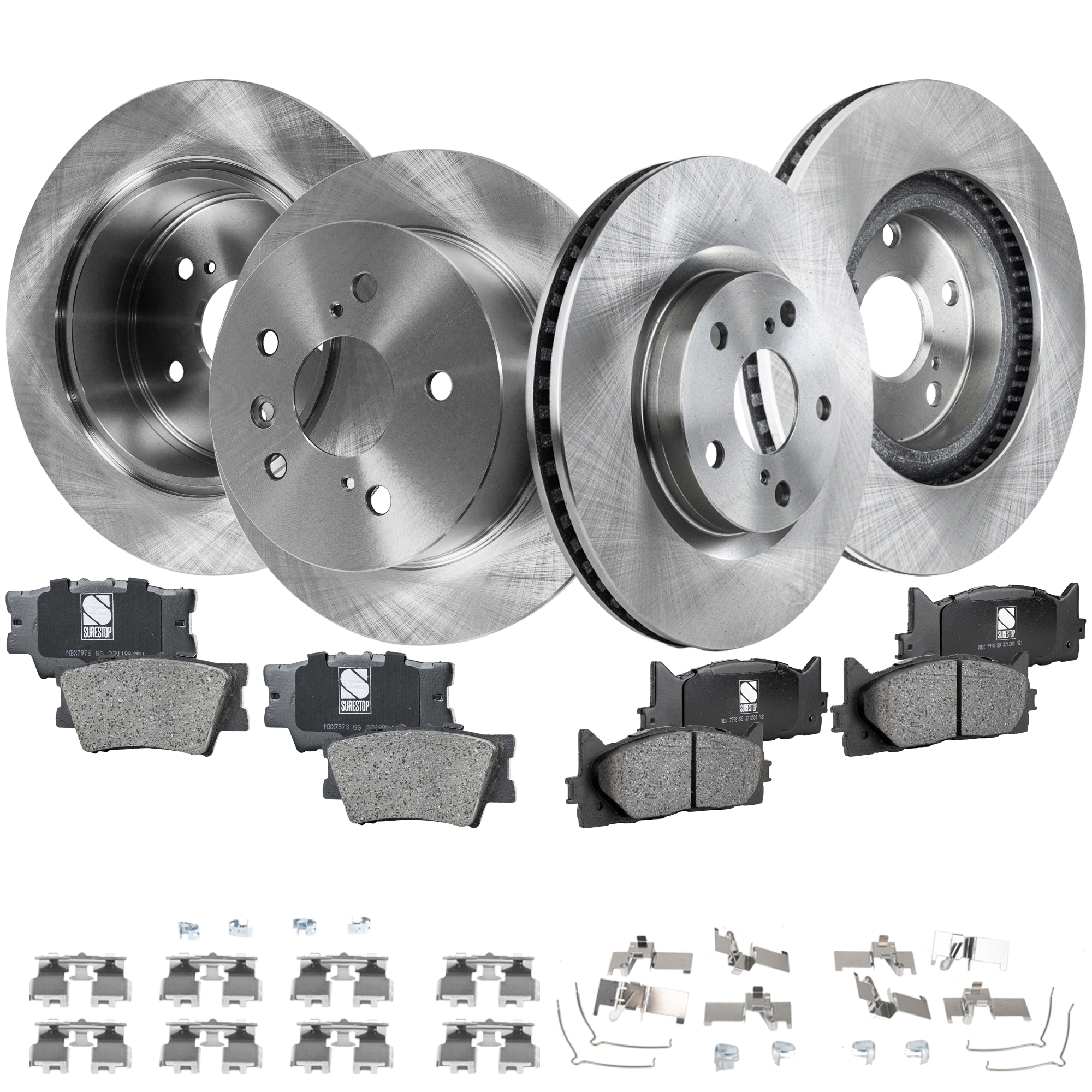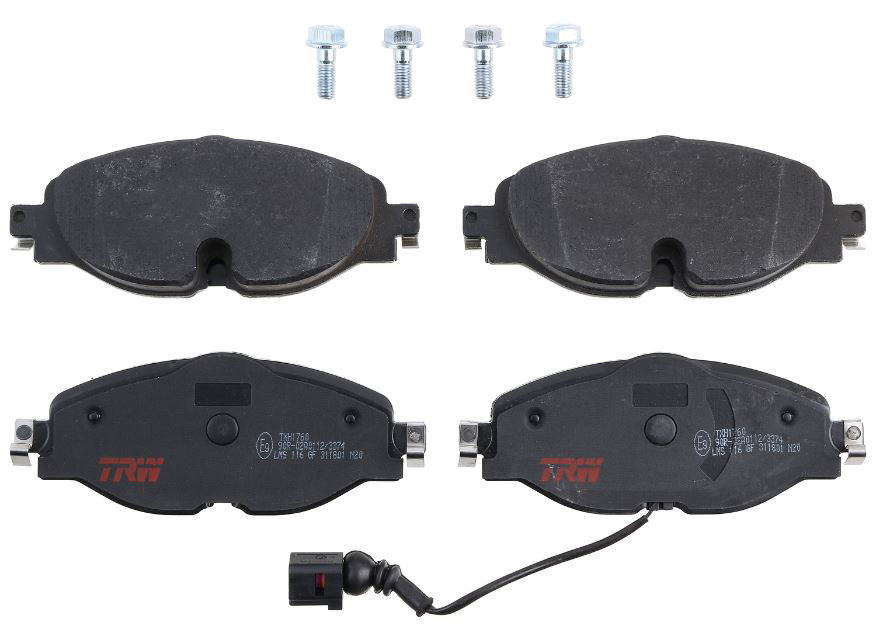Fully functioning brake pads are essential. You rely on your vehicle’s brake components every time you press down on the brake pedal. If your brake pads are thin or have uneven wear, you might not have your brake’s full stopping power when you need it the most.
How Does a Disc Brake Work?
The caliper and the brake pad act like a clamp. They’re both stationary because they’re connected to the wheel hub. Meanwhile, the metal brake disc is connected to and spins alongside the wheel. When the driver presses the brake pedal, high-pressure brake fluid is sent to all four brake calipers, which clamp onto the brake rotor. This slows the wheel down, which in turns slows the vehicle.

The brake calipers use brake pads to clamp onto the brake rotor. Brake pads use a special compound that can regularly withstand the friction between the brake pads and the rotor.
The caliper housing slides on guide pins that allow it to “float.” If one of these guide pins is seized (and it happens quite a lot), uneven brake pad wear will be the result. Usually, the pad showing the most wear will be the one on the piston side of the rotor.
Brake pads are regularly subjected to immense heat and pressure. As a result, brake pad replacements are commonplace in vehicle repair maintenance schedules because they’re made from non-metal, semi-metal, or ceramic composites that turn to dust after a certain amount of use. Rural letter carriers may replace their brake pads as often as once per month.
Why Is Even Brake Pad Wear Important?
Checking brake pad wear should be part of your vehicle’s routine maintenance. Uneven brake pad wear can be a sign of a problem in your braking system. Uneven brake pad wear can also lead to faster brake pad wear, which can result in your vehicle running out of brake pads faster than its expected lifespan.
This can damage the brake rotors and calipers due to metal-on-metal contact, which will also create loud grinding noises and vibrations. Without brake pads, your vehicle will also have less braking power.

Brake Wear Patterns

When you inspect your vehicle’s brake pads, you need to pay attention to how each pad has worn out in relation to its corresponding pair. On some vehicles, you can see the brake pads through the holes in the wheel by shining a flashlight at the calipers. On other vehicles, you might need to remove the vehicle’s wheels to have a clear view of the brake pads’ thickness. The brake wear pattern will let you know if there’s an issue with your braking system.
Inner Pad Wear
A more worn-out inner pad is the most common type of uneven brake pad wear. The inner pad is the pad located closer to the vehicle’s body. While it’s normal for a floating caliper system to have increased wear on the inner pad, the difference between the worn-out rotor and its pair should only be 2-3 millimeters.
Outer Pad Wear
Having an outer brake pad that’s more worn out than the inner pad is rarer. This typically happens when both slide pins are seized and the caliper can’t float. When replacing the pads, check the pins, replace any damaged pin seals, and lubricate the pins so that they move freely in and out of their small bores in the caliper bracket. In extreme cases, the caliper bracket may need to be replaced.
Tapered Pad Wear
If the brake pad wear is wedge-shaped or tapered, the caliper might have too much mobility or one of the slide pins will typically be seized.
Common Causes of Uneven Brake Pad Wear
There are several potential causes for uneven brake pad wear, and each has its own risks.
Faulty or Corroded Slide Pins
The slide pins can corrode over time and seize. Since slide pins operate in pairs, the brake pads will show uneven or tapered wear, since one side will work freely and the other will be seized.
Failed or Sticky Caliper Pistons
A sticky caliper occurs when you press on the brake and the caliper refuses to press on the brake disc. This issue can be caused by debris and rust forming inside the caliper, preventing it from sliding from side to side. A sticky caliper can either refuse to engage at all or refuse to return to its original position. This is typically because of moisture in the brake fluid.

Misaligned Wheels
Misaligned wheels or loose front end parts can cause the front wheels to pull to one side when braking. The uneven braking can cause one side of the brake pads to receive more wear than the other.
While uneven brake wear might not be a serious issue, you should remember that it can snowball into a larger issue and lead to an accident if ignored. During scheduled vehicle maintenance, ask your mechanic if they’ve observed uneven brake wear and if so, if anything needs to be done.
Get Reliable Brake Pad Sets For Your Car
When the brake pads become too thin or uneven, you must replace them as soon as possible. Don’t drive your car until you’ve installed new brake pads to avoid additional brake problems that will cost more to fix. Fortunately, CarParts.com can help you get your vehicle back on the road with a replacement brake pad set.
CarParts.com offers brake pad sets that contain the parts you need to restore your car’s braking performance. Sourced from brands trusted by drivers across the US, our products give you the most bang for your buck. Once you complete our straightforward ordering process, you won’t have to wait long for your brake pad set’s arrival. If you live in the continental US and order before noon ET, we’ll deliver your parts to your doorstep in as fast as two business days.
Get brake pad sets that you can rely on here at CarParts.com. Check out our selection of high-quality brake pad sets and enjoy great discounts!
Shop this Project



Any information provided on this Website is for informational purposes only and is not intended to replace consultation with a professional mechanic. The accuracy and timeliness of the information may change from the time of publication.

































